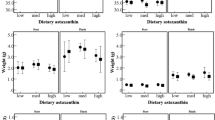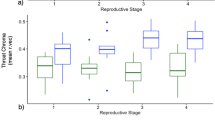Summary
A necessary condition of most models of intersexual selection requires that secondary sexual traits are costly so that cheating is prevented. If the conspicuous breeding colouration of male three-spined sticklebacks (Gasterosteus aculeatus L.) is such a handicap, it must involve costs. I examined the energetic costs of the breeding colouration by varying the energy contents of the daily food supply among five groups of sticklebacks over a 10 week period. The nutritional carotenoid level, i.e. the colour pigment used in the breeding colouration, was constant for all fish. Both the increase of their condition factor and the condition level they finally achieved correlated positively with the food ration of the groups. Individuals whose condition increased during the experiment developed a more intensive red colouration. However, a direct correlation between food quantity and the red breeding colouration reached at the end of the experiment did not exist. Nevertheless, given the limitation of pigment availability, there was still variation in the breeding colouration and the costs for the metabolism of the colouration were sufficient to render it an honest signal: a female stickleback can assess a male's condition and condition change over the past few weeks by the intensity of the colour of his blue eyes (which is not based on carotenoids and whose pigments were therefore not controlled in the food) and his red jaw, respectively. How much an individual male fish invests in increase of length and increase of condition (which correlate negatively with each other) seems to be, at least partly, his own strategic decision, which could have important consequences in the competition for female mates. It is eventually this decision that a male stickleback seems to signal with his red jaw.
Similar content being viewed by others
References
Andersson, M. (1982) Sexual selection, natural selection and quality advertisement.Biol. J. Linn. Soc. 17, 375–93.
Ando, S., Takeyama, T., Hatano, M. and Zama, K. (1985) Carotenoid-carrying lipoproteins in the serum of Chum Salmon (Oncorhynchus keta) associated with migration.Agric. Biol. Chem. 49, 2185–7.
Baggerman, B. (1985) The role of biological rhythms in the photoperiodic regulation of seasonal breeding in the sticklebackGasterosteus aculeatus L.Netherlands J. Zool. 35, 14–31.
Bell, G. (1978) The handicap principle in sexual selection.Evolution 32, 872–85.
Bolger, T. and Connolly, P.L. (1989) The selection of suitable indices for the measurement and analysis of fish condition.J. Fish Biol. 34, 171–82.
Brush, A.H. (1981) Carotenoids in wild and captive birds. InCarotenoids as Colorants and Vitamin A Precursors, (J.C. Bauernfeind, ed.), pp. 539–62. Academic Press, NY, USA.
Brush, A.H. (1990) Metabolism of carotenoid pigments in birds.FASEB J. 4, 2969–77.
Brush, A.H. and Reisman, H.M. (1965) The carotenoid pigments in the three-spined stickleback,Gasterosteus aculeatus.Comp. Biochem. Physiol. 14, 121–5.
Czeczuga, B. (1980) Carotenoids in fish.Pungitius pungitius (L.) andGasterosteus aculeatus L. (Gasterosteidae).Hydrobiologia 74, 7–10.
Endler, J.A. (1980) Natural selection on color patterns inPoecilia reticulata.Evolution 34, 76–91.
Endler, J.A. (1983) Natural and sexual selection on color patterns in poeciliid fishes.Environ. Biol. Fish. 9, 173–90.
Endler, J.A. (1990) On the measurement and classification of colour in studies of animal colour patterns.Biol. J. Linn. Soc. 41, 315–52.
Fisher, R.A. (1930)The Genetical Theory of Natural Selection. Clarendon Press, Oxford, UK.
Fujii, R. (1969) Chromatophores and pigments. InFish Physiology III, (W.S. Hoar and D.J. Randall, eds), pp. 307–53. Academic Press, NY, USA.
Gaines, S.D. and Rice, W.R. (1990) Analysis of biological data when there are ordered expectations.Am. Nat. 135, 310–17.
Goodman, D. (1982) Optimal life histories, optimal notation, and the value of reproductive value.Am. Nat. 119, 803–23.
Grafen, A. (1990a) Sexual selection unhandicapped by the Fisher Process.J. Theor. Biol. 144, 473–516.
Grafen, A. (1990b) Biological signals as handicaps.J. Theor. Biol. 144, 517–46.
Halver, J.E. (1957) Nutrition of salmonoid fishes: III. Water-soluble vitamin requirements of chinook salmon.J. Nutr. 62, 225–43.
Hamilton, W.D. and Zuk, M. (1982) Heritable true fitness and bright birds: a role for parasites?Science 218, 384–7.
Hasson, O. (1989) Amplifiers and the handicap principle in sexual selection: a different emphasis.Proc. R. Soc. London B 235, 383–406.
Hynes, H.B.N. (1950) The food of fresh-water sticklebacks (Gasterosteus aculeatus andPygosteus pungitius), with a review of methods used in studies of the food of fishes.J. Anim. Ecol. 19, 36–58.
Iwasa, Y., Pomiankowski, A. and Nee, S. (1991) The evolution of costly mate preferences. II. The ‘handicap’ principle.Evolution 45, 1431–42.
Kirkpatrick, M. (1982) Sexual selection and the evolution of female choice.Evolution 36, 1–12.
Kirkpatrick, M. (1986) Sexual selection and cycling parasites: a simulation study of Hamilton's hypothesis.J. Theor. Biol. 119, 263–71.
Kirkpatrick, M. (1987) Sexual selection by female choice in polygynous animals.Ann. Rev. Ecol. Syst. 18, 43–70.
Kirkpatrick, M. and Ryan, M.J. (1991) The evolution of mating preferences and the paradox of the lek.Nature 350, 33–8.
Kodric-Brown, A. (1989) Dietary carotenoids and male mating success in the guppy: an environmental component to female choice.Behav. Ecol. Sociobiol. 25, 393–401.
Lande, R. (1981) Models of speciation by sexual selection on polygenic traits.Proc. Natl Acad. Sci. USA 78, 3721–5.
Lande, R. and Arnold, S.J. (1985) Evolution of mating preference and sexual dimorphism.J. Theor. Biol. 117, 651–64.
Le Cren, E.D. (1951) The length—weight relationship and seasonal cycle in gonad weight and condition in the perch (Perca fluviatilis).J. Anim. Ecol. 20, 201–19.
Lythgoe, J.N. (1979)The Ecology of Vision. Clarendon Press, Oxford, UK.
McLennan, D.A. and McPhail, J.D. (1989) Experimental investigation of the evolutionary significance of sexually dimorphic nuptial colouration inGasterosteus aculeatus (L.): temporal changes in the structure of male mosaic signal.Can. J. Zool. 67, 1767–77.
Michod, R.E. and Hasson, O. (1990) On the evolution of reliable indicators of fitness.Am. Nat. 135, 788–808.
Milinski, M. and Bakker, Th. C.M. (1990) Female sticklebacks use male coloration in mate choice and hence avoid parasitized males.Nature 344, 330–2.
National Research Council (1973)Nutrient Requirements of Trout, Salmon, and Catfish. National Academy of Sciences, Washington, DC, USA.
Nur, N. and Hasson, O. (1984) Phenotypic plasticity and the handicap principle.J. Theor. Biol. 110, 275–97.
O'Donald, P. (1962) The theory of sexual selection.Heredity 17, 541–52.
Pomiankowski, A. (1987) Sexual selection: the handicap principle does work — sometimes.Proc. R. Soc. London B 231, 123–45.
Pomiankowski, A., Iwasa, Y. and Nee, S. (1991) The evolution of costly mate preferences. I. Fisher and biased mutation.Evolution 45, 1422–30.
Ricker, W.E. (1979) Growth rates and models. InFish physiology Vol. VIII (W.S. Hoar, D.J. Randall and J.R. Brett, eds), pp. 677–743. Academic Press, London, UK.
Simpson, K.L., Katayama, T. and Chichester, C.O. (1981) Carotenoids in fish feeds. InCarotenoids As Colorants And Vitamin A Precursors (J.C. Bauernfeind, ed.), pp. 462–538. Academic Press, NY, USA.
Titschack, E. (1922) Die sekundären Geschlechtsmerkmale vonGasterosteus aculeatus. L.Z. Jahrb. Physiol. 39, 83–148.
Torrissen, O.J., Hardy, R.W. and Shearer, K.D. (1989) Pigmentation of salmonids — carotenoid deposition and metabolism.Aquat. Sci. 1, 209–25.
Wedekind, C. (1992) Detailed information about parasites revealed by sexual ornamentation.Proc. R. Soc. London B 247, 169–74.
Wootton, R.J. (1976)The Biology of the Sticklebacks. Academic Press, London, UK.
Zahavi, A. (1975) Mate selection — a selection for a handicap.J. Theor. Biol. 53, 205–14.
Zahavi, A. (1977) The costs of honesty (further remarks on the handicap principle).J. Theor. Biol. 67, 603–5.
Zeh, D.W. and Zeh, J.A. (1988) Condition-dependent sex ornaments and field tests of sexual-selection theory.Am. Nat. 132, 454–9.
Author information
Authors and Affiliations
Rights and permissions
About this article
Cite this article
Frischknecht, M. The breeding colouration of male three-spined sticklebacks (Gasterosteus aculeatus) as an indicator of energy investment in vigour. Evol Ecol 7, 439–450 (1993). https://doi.org/10.1007/BF01237640
Issue Date:
DOI: https://doi.org/10.1007/BF01237640




